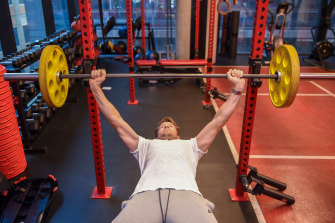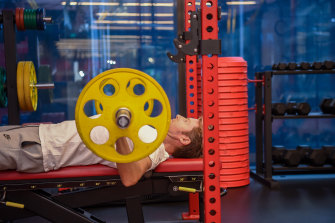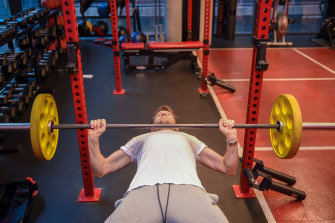Home » Health News »
There’s a lot to control: Your complete guide to the bench press
When it comes to exercising at the gym, getting your technique right is crucial. In this series, physiotherapist Luke Pickett takes us step-by-step through the big three movements: the squat, the deadlift and the bench press.
There is no exercise that is more status-defining in the fitness world than the bench press. “How much do you bench?” is the catch-cry of gym junkies the world over.
It’s one of the staple exercises of an upper body training routine, but it’s also one of the easiest exercises to get wrong and thus, cause injury. So let’s shed some light on this classic move.
Physiotherapist Luke Pickett performing a bench press.Credit:Justin McManus
An overview
The bench press is an easy way of putting more load or weight on a push-up. For the uninitiated, a simplified explanation would be to imagine a push-up flipped on its back. Whilst lying on your back, with your arms out to the side, the hands push away from the body into the air and then return to chest level. It’s a compound movement that predominantly targets the chest (pectoral muscles), shoulders (deltoid muscles) and back of the arms (triceps).
Like any weighted exercise, there is a greater risk of injury compared with a body weight equivalent. This risk is increased again when a movement involves multiple joints, therefore requiring a lot of control.
It’s worth noting that if you focus too much on the bench press and neglect the opposing back muscles, then you’ll create a muscle imbalance. You will start to round your shoulders (pulling your shoulders forwards and towards the sternum) leading to poor posture. This rounding will risk shoulder injury over time and cause pain, which will be exacerbated by more bench pressing over time. But there is a safe way to perform the exercise.
Technique
Start with the weight. There are two options with the bench press. A barbell (one bar about two metres long with round weights stacked on each end) is the more traditional method and more commonly used. You can also go with two dumbbells (an individual weight, held in each hand separately), which is my personal preference as it promotes symmetry and when performed with good technique is much safer.
To set up, lie on a horizontal weight bench with your back flat. It’s crucial to keep your lumbar (lower back) and cervical (neck) spine neutral to prevent injury (this means it isn’t curving either way, and there shouldn’t be a gap between your lower back and the bench, though a very slight gap is acceptable). The classic set-up is to have your feet planted on the ground and knees bent at about 90 degrees. But it can be hard to maintain the correct spine position if you are of shorter stature or highly flexible, or if your bench isn’t low enough. It’s why in my work, I usually recommend people put their feet flat up on the bench, so their hips are bent at 45 degrees and the knees bend at 90 degrees.
Keep your back flat on the bench, Luke Pickett recommends.Credit:Justin McManus
To keep the cervical spine neutral, focus on a point on the roof directly above your head, keeping a subtle nod throughout the movement. Don’t raise your head off the bench or tilt it backwards so the chin moves away from the chest. Concentrate on your lift. For novice bench-pressers and those rehabilitating from a shoulder injury, I’ll often have the patient lying on the floor to work through the fundamentals in this supported position.
Pay close attention to the positioning of your elbows.Credit:Justin McManus
There are a lot of components to the movement, so let’s go in order. For ease of explanation, we’ll begin with the weight at the lower, chest position.
The most common errors with bench pressing come from people lifting too great a weight, holding their breath, curving their upper back forwards, letting the shoulder blades slide around the rib cage, lifting their lower back off the bench or moving their neck during the lift. There really is a lot to control!
Feel the burn in your pectorals, front of deltoids and triceps. Take note of where the burn is and this will guide you on which body part needs to be targeted next. You can really learn a lot by being aware of these details – and that goes for all your exercises.
If you’re using a barbell, build up from a low weight. Consider using just the bar itself to begin with. Being pinned or choked by an inanimate object is not the best way to start your bench-pressing venture.
Start with three sets of 8-10 repetitions and as the last repetitions of the third set become easy over a few weeks of training, then feel free to increase the weight (maximum of 10 per cent increase per progression).
Keep in mind that the bench press puts significant load through the acromioclavicular joint (where your collarbone meets the outer most point of the shoulder blade) and can contribute to osteo-arthritis, so be sensible with your weight selection and technique.
Always ensure that you stretch your pectoral muscles post-workout and don’t skip on training the opposing back muscles with strength exercises like seated rows or one arm rows.
Luke Pickett is a physiotherapist who has worked as a head physio for AFL, AIS and Australian sporting teams. He is director of Melbourne Physio Clinic.
Also check out his complete guide to the squat. And next week we’ll be back with a guide to the deadlift.
Make the most of your health, relationships, fitness and nutrition with our Live Well newsletter. Get it in your inbox every Monday.
Most Viewed in Lifestyle
From our partners
Source: Read Full Article





